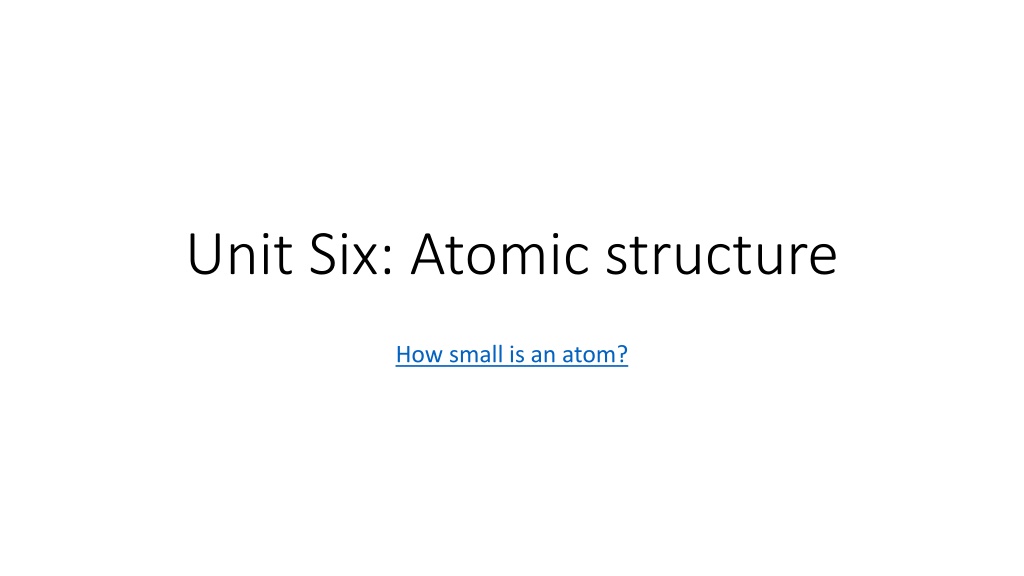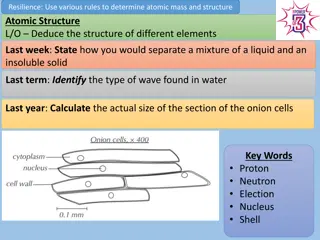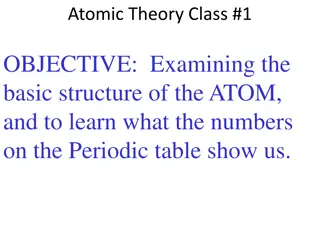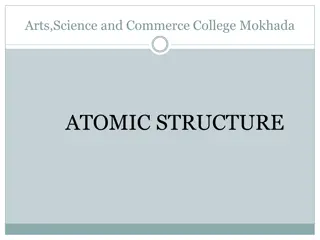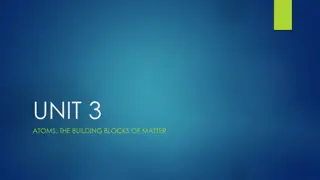Understanding Atomic Structure and Laws of Matter
Explore the fundamental concepts of atomic structure, including the size of atoms, evidence of atomic composition, and key laws of matter such as the Law of Conservation of Mass. Delve into the historical understanding of atomic structure and the contributions of significant scientists like John Dalton. Discover how principles of chemistry are applied through experiments and calculations, emphasizing the importance of balancing equations and maintaining constant composition in substances.
Download Presentation

Please find below an Image/Link to download the presentation.
The content on the website is provided AS IS for your information and personal use only. It may not be sold, licensed, or shared on other websites without obtaining consent from the author. Download presentation by click this link. If you encounter any issues during the download, it is possible that the publisher has removed the file from their server.
E N D
Presentation Transcript
Unit Six: Atomic structure How small is an atom?
Evidence of Atomic Structure An understanding of how matter behaves and the understanding of atomic structure did not develop until scientists were able to measure Mass. Use of a balance to measure the mass of materials and to monitor chemical reactions, lead to the three basic properties of matter:
The Law of Conservation of Mass Matter is neither created or destroyed in a chemical reaction . Which means: the mass of the substances produced (products) in a chemical reaction is always equal to the mass of the reacting substances (reactants).
Law of Constant Composition In a pure substance, the elements are always present in the same proportion by mass. For example: Water will always be composed of two Hydrogen atoms : 1 oxygen atom. That means: 12% of the mass is Hydrogen and 88% of the mass is oxygen . It doesn t matter how much you have a cup full or an ocean worth of water! H2O
Law of Multiple Proportions When two elements, A and B, combine to form more than one compounds, the mass of A and B will combine in simple ratios. Mass measurements would reflect the 1:2 ratio of carbon and oxygen in CO2 and the 1:1 ratio in CO.
Prove it: Law of Conservation of Mass Objective: Conduct an experiment to see if the law of conservation of mass is true.
Applying laws of matter to chemistry: Applying laws of matter to chemistry: 1. Balancing equations. 2. Naming compounds and writing formulas 3. Chemical analysis.
Historical Understanding of Atomic Structure Historical Understanding of Atomic Structure Important Scientists and their contributions to atomic theory: John Dalton: Used evidence from many experiments (change in mass/balances) Identified basic properties of elements and how atoms interact and form compounds. All elements consist of atoms that cannot be divided. Atoms of different elements have different masses. Atoms of one element cannot be changed into atoms of another element by chemical reactions. Compounds are formed when atoms of more than one element combine in specific ratios.
Important Scientists and their contributions to atomic theory: JJ Thompson Used a cathode ray tube (vacuum tube containing a gas) Discovered that atoms contain electrons (negatively charged particle) He thought that electrons were scattered throughout the atom along with positive charge particles, plum pudding model.
Thomsons Atomic Model Thomson believed that the electrons were like plums embedded in a positively charged pudding, thus it was called the plum pudding model.
Important Scientists and their contributions to atomic theory Important Scientists and their contributions to atomic theory: Ernest Rutherford: Gold Foil Experiments Discovered the positively charged nucleus of the atoms. He suggested that the atom is mostly empty space but has a positive charge in the center. Rutherford called the positively charged particles protons.
Rutherfords Gold Foil Experiment Alpha particles are helium nuclei Particles were fired at a thin sheet of gold foil Particle hits on the detecting screen (film) are recorded
Try it Yourself! In the following pictures, there is a target hidden by a cloud. To figure out the shape of the target, we shot some beams into the cloud and recorded where the beams came out. Can you figure out the shape of the target?
The Answers Target #1 Target #2
Rutherfords Findings Most of the particles passed right through A few particles were deflected VERY FEW were greatly deflected Like howitzer shells bouncing off of tissue paper! Conclusions: The nucleus is small The nucleus is dense The nucleus is positively charged
Important Scientists and their contributions to atomic theory Important Scientists and their contributions to atomic theory: Neils Bohr: Suggested that electrons are found in orbits around the nucleus.
Atomic Structure and Cloud Model: More recent research suggests that electrons move rapidly within cloud-like regions called orbitals: James Chadwick latter identified that the nucleus also contains neutrons which have no charge)
The Structure of the Atom Subatomic particle Location Charge Property Contributes mass Little space Proton Nucleus + Contributes mass Little space Neutron Nucleus Neutral Little/no mass Provides space Electron Orbital -
Understanding Nuclear Symbols Atomic Number (Z)- the number of protons in the nucleus. Atomic Mass (A)- the number of protons (Z) + neutrons (N) in the nucleus.
Practice: Name= Chlorine Atomic Number (Z) = 17 Atomic Mass = 35 # Protons = 17 # Neutrons = 18 (35-17 = 18) # Electrons 17
Atomic Structure & Counting Atoms Atomic number- defines the number of protons in the nucleus of an atom Atomic mass - the mass (weight) of an atom Mass Number- the sum of the number of protons and neutrons in the nucleus of an atom. Atomic Number Atomic mass Mass Number # of protons # of electrons # of neutrons Element Symbol Aluminum Al 13 26.98 27 13 13 14
Changing Atoms Ions: electrically charged atoms formed by the loss or gain of electron(s). Isotopes: atoms of the same element that have a different atomic mass. (protons remain the same but the neutrons are different).
Changing Atoms: Changing Atoms: Ion Add/remove electrons Atom Isotope Add/remove neutrons
Ions: Cation: positively-charged (+) ion formed when an atom loses electrons I positively love cats Anion: negatively-charged (-) ion formed when an atom gains electrons
Counting Ions: Sodium Ion Protons = _____________ Neutron = ____________ Electrons = _____________
Practice: Ions Element/ Ion Atomic Number Mass Number Protons Neutrons Electrons Ca2+ 20 40 20 20 18 Cl- 17 35 K+ 19 39 O2- 8 16
Isotopes and Average Atomic Mass: Isotopes are atoms that have the same atomic number but different mass number. This means that isotopes have the same number of protons but a different number of neutrons. Remember that protons and neutrons are located in the nucleus of the atom. The average atomic mass descries the average mass of all the naturally occurring isotopes for an element according to their natural abundance.
Calculating the Average Atomic Mass: The average atomic mass is calculated by added the contributing mass of each isotope based on its natural abundance (% amt.) Chlorine (Cl) has two naturally occurring isotopes: 35.0 amu 75.5% 37.0 amu 24.5% Average = (35.0 x .755)+ (37.0 x .245) = 35.5amu
Practice: Ions & Isotopes Atomic Number Element/Ion Atomic Mass Mass number Protons Neutrons Electrons H 1 1.01 1 1 0 1 1 1.01 1 1 0 0 H+ 612C 37Li+ Cl-
